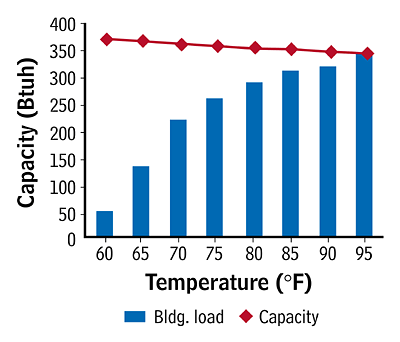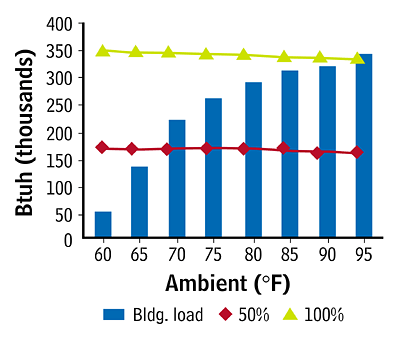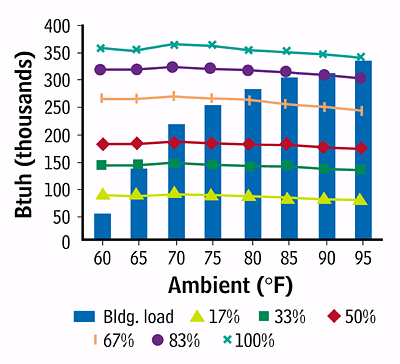The challenge, then, is selecting a packaged rooftop unit that can handle the peak design cooling load and also maintain control of indoor comfort during the non-peak times of the year.

Looking Through The Bin Hourglass
One method commonly used to illustrate the range of design temperature conditions over the entire year is the bin hour profile. A "bin" is simply a five-degree range of temperatures, along with the number of hrs of occurrence between summer and winter design temperatures. When shown graphically, a bin hour profile shows that most operating hrs throughout the year occur at off-peak temperatures.As the example in Figure 1 shows, during most hrs of the year, the drybulb temperature is between 45°F and 75°F in Charlotte, NC. Although the summer design temperature is 95°F and the winter design temperature is 15°F, these temperatures occur very few hrs each year. This is why a part-load analysis should be performed to predict the interaction between the heating and cooling equipment and the building load.
Although a bin hour profile is useful to analyze drybulb temperatures, at each drybulb condition there is also a mean coincident wetbulb temperature, which represents the average wetbulb temperature at that drybulb. In many humid parts of the country, especially in applications with high quantities of outside air, the design wetbulb temperature may dictate the design operating condition for the unit. This is one reason that ASHRAE now lists a table indicating design wetbulb and mean coincident drybulb.
Regardless of which design temperature is used, drybulb or wetbulb, a packaged rooftop unit must be capable of maintaining the desired building temperature and humidity levels at these design conditions. This is the easy part for rooftop equipment.
As mentioned above, the design drybulb conditions occur at less than 5% of the cooling hours available. At ambient temperatures below design conditions, the building load is decreasing, while the full-load capacity of the rooftop equipment is actually increasing. This is illustrated in Figure 2.
This represents a challenge in controlling the packaged rooftop equipment to maintain comfort levels within the space. Buildings with oversized equipment tend to be cold and clammy as the air conditioning systems tend to have wide on and off cycles. During the on cycle, these systems tend to blast large volumes of very cold air that satisfy thermostats quickly and cycle the units off.
During the off cycles, the inactive cooling coil is performing no dehumidification and the space becomes uncomfortably humid. In fact, during off cycles, rehumidification occurs as untreated moist ventilation air is introduced to the space. Also, the residual water on the indoor coil re-evaporates into the untreated airstream during the off cycles. At temperatures below design conditions, most equipment has excess capacity, so this rehumidification becomes a real comfort and indoor air quality (IAQ) issue.

Sizing Equipment
First and foremost, the units should be sized properly. This means performing an accurate cooling load analysis and resisting the temptation to throw in ultraconservative safety factors resulting in oversized units. This only serves to further the problems stated above. If a safety factor is applied during the load estimate calculation and then the next-largest unit is selected, in effect the system will be grossly oversized.Indoor relative humidities in excess of 60% have been attributed to the creation of IAQ problems such as "Sick Building Syndrome" since microorganisms thrive in humid conditions. In addition to causing short-cycling of the equipment and humid conditions in the space, oversized equipment results in undesirable noise levels as well as drafts, and it ultimately creates higher installed and operating expenses for the building owner or tenants.
There are several easy-to-use load-estimating software programs available for calculating building loads and sizing the hvac equipment. These have proven to be valuable tools for the designer in terms of both accuracy and saving time. Once the design loads have been calculated, equipment selection and layout tasks are performed.

The Basics
Packaged rooftop units must be capable of operating over a wide variety of loading conditions, from full load to very low loads to anything in between. To achieve this, the unit should be equipped with as many capacity stages as possible to closely match the building load profile. Sufficient capacity stages will help prevent excessive compressor cycling and more accurately maintain the desired leaving-air temperature.The simplest rooftop system is the constant-volume unit serving a single zone, which may vary in size from as small as 500 sq ft to over 50,000 sq ft. Constant volume means the supply airflow quantity is constant at all times. Typical control of a constant-volume unit is achieved by using a single thermostat to turn the unit on for heating-cooling and off when the space is within one or two degrees of the desired setpoint.
Often, these systems have at least two stages of cooling, so that at part load, only a portion of the units' cooling capacity is energized, preventing excessive on-off cycling and wide swings in indoor temperature and humidity. Two-stage cooling is often accomplished by having two independent refrigerant circuits within the rooftop unit.
Some large, packaged rooftop units use multiple compressors on each refrigerant circuit, allowing more than the two stages of capacity control. These systems must use a control that will allow the multistaging of the compressors.
For example, a unit may have two independent refrigeration circuits with two compressors on each circuit. Since most commercial thermostats have two stages of control, the unit will need an alternate method - sometimes called a controller - to cycle these compressors to obtain the four stages of capacity available.
To prevent rapid cycling of the compressors, a time delay is often built in, ensuring that at least five minutes elapse between on-off cycles.
Another capacity control device used with these units is a suction pressure unloader. This control is used on semi-hermetic compressors and actually prevents refrigerant gas from entering compressor cylinders when suction pressure drops, signifying low building loads. These unloaders need no external controls and should automatically match the rooftop unit's capacity to the building load.
Other benefits of this control include less compressor on-off cycling and the ability to use standard two-stage thermostats to control the rooftop unit. Using suction pressure unloaders may allow rooftop units as small as 20 tons to have up to six capacity stages, improving temperature and humidity control as the rooftop unit capacity more closely matches the building load without excessive on-off cycling.

Choices For Vav Systems
Packaged rooftop systems have gained popularity in variable air volume (vav) applications, where the vav rooftop unit serves many zones within a building by supplying a varying amount of air at a constant supply air temperature. The volume of air is regulated either by fan speed or by changing the flow characteristics of the fan wheel itself.With vav systems, the most common forms of capacity staging are compressor cycling and compressor cylinder unloading. Compressor cycling involves simply turning individual compressors on and off. Cylinder unloading closes internal passageways within the compressor to prevent compression and, therefore, reduces the mass flow of refrigerant.
Cycling compressors can be effective if the unit has enough compressors to allow it to reduce capacity as the building load drops. If not, excessive compressor cycling and poor temperature control may result.
For example, on a 30-ton packaged rooftop unit with two equally sized hermetic compressors, you have only two stages of capacity, each stage equal to 15 tons. If the building load is 20 tons, the second-stage compressor must cycle on and off to attempt to manage the building load. Likewise, if the building load drops to 10 tons, the first stage compressor must cycle. This intermittent cycling may cause accelerated wear and tear on the compressor and may cause swings in indoor temperature and humidity. The gap in unit capacity vs. building load is shown in Figure 3.
Cylinder unloading is a popular method of increasing capacity staging while minimizing compressor cycling, and aids the unit control system by controlling the discharge air temperature setpoint. Possible with semi-hermetic compressors, cylinder unloading essentially shuts down two or more cylinders, thereby reducing compressor output.
With semi-hermetic compressors and cylinder unloading, the 30-ton rooftop unit mentioned previously may now achieve as many as six stages of capacity control (Figure 4). These additional stages allow the rooftop unit to more closely control its capacity to the actual building load, meaning much less cycling of compressors.
This improves the unit's performance and tends to provide a more stable control of indoor relative humidity and temperatures.
Conclusion
Modern buildings, and older ones too, require increasing levels of sophistication when it comes to balancing the needs for economic building operation and maintaining a comfortable, healthy environment. Fortunately, today's packaged rooftops and control systems provide greater flexibility to meet the challenges.Maximum design load conditions are still an important consideration when selecting packaged rooftop units, although they will seldom need to operate at these design conditions. Therefore, the specifying engineer should break with tradition and examine not just the maximum needs of the building, but the part-load capabilities that will be required more often than not.
By doing so, the engineer will ensure a successful union of consistent comfort, proper temperature and humidity control, and optimal system performance. ES
